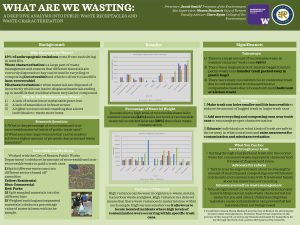What are We Wasting: A Deep Dive Analysis into Public Waste Receptacles and Waste Characterization
Waste management is constantly changing, and better means of proper waste characterization are being developed. Still, the mischaracterization of materials occurs frequently. Reducing the number of emissions produced by landfills is detrimental due to a lack of amenities and infrastructure, education, and different behaviors from individuals in different socioeconomic standings. Partnering with the City of Renton Public Works Department, A study was created,
implemented, and published to understand the amount of recoverable and non-recoverable material within public waste cans in commercial, residential, and parks sectors. Around half of the waste found within this study when examining trash in public waste cans could have been composted or recycled. There was a large amount of individually bagged trash within each public waste can, making it difficult for individuals to separate and adequately characterize their waste. This study sought to understand the barriers to proper characterization. I believe an increase in composting and recycling cans will increase the accessibility of recycling and composting. As well as reducing the sizes of openings for public trash cans so individuals can characterize their waste correctly and proper education around sustainability, composting, and recycling can help to increase the amount of recoverable waste used in composting and recycling as well as reduce the amount of waste that ends up in landfills. Recycling and composting will only become more critical as time goes on, as landfills create more and more greenhouse gas emissions, and more trash is added to landfills.
